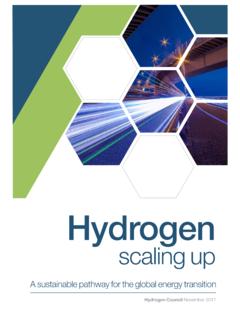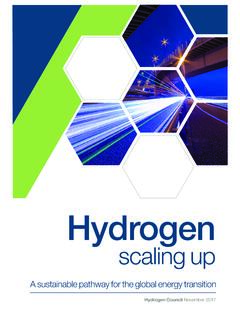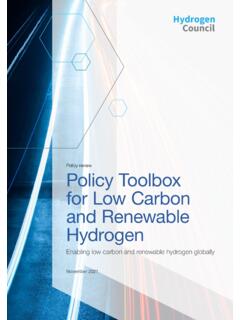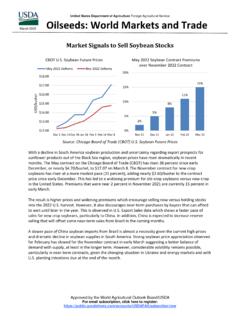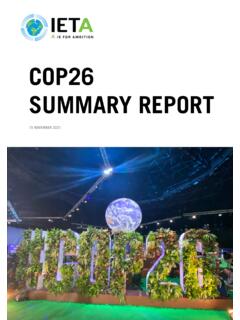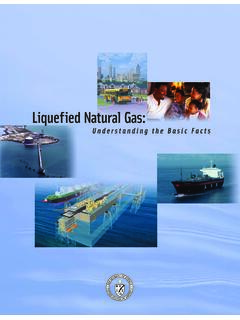Transcription of Hydrogen Insights
1 Hydrogen Insights An updated perspective on Hydrogen investment, market development and momentum in ChinaJuly 2021 Hydrogen Insights July 2021 UpdateHydrogen council , McKinsey & CompanyPublished in July 2021 by the Hydrogen council . Copies of this document are available upon request or can be downloaded from our website: This report was authored by the Hydrogen council in partnership with McKinsey & Company. The authors of the report confirm that: 1. There are no recommendations and/or any measures and/or trajectories within the report that could be interpreted as standards or as any other form of (suggested) coordination between the participants of the study referred to within the report that would infringe EU competition law; and2. It is not their intention that any such form of coordination will be adopted.
2 Whilst the contents of the Report and its abstract implications for the industry generally can be discussed once they have been prepared, individual strategies remain proprietary, confidential and the responsibility of each participant. Participants are reminded that, as part of the invariable practice of the Hydrogen council and the EU competition law obligations to which membership activities are subject, such strategic and confidential information must not be shared or coordi-nated including as part of this Report. 3 Hydrogen Insights July 2021 UpdateHydrogen council , McKinsey & Company Executive summaryHydrogen momentum continues to grow. Since the publication of the Hydrogen Insights report in February 2021, more countries have committed to decarbonization targets and large-scale clean Hydrogen projects have been announced, amounting to over ten million tons of total capacity by 2030 or about a third of total clean Hydrogen demand growth expected in the next decade.
3 For the international shipping of Hydrogen , ammonia, LOHC and liquid Hydrogen are the main considered vectors. While Europe and East Asia continue to lead in Hydrogen , regions rich in renewables and carbon storage are stepping in to supply clean Hydrogen . And China is emerging as a potential Hydrogen giant: following its announcement to target net-zero emissions by 2060, plans to achieve peak carbon in various sectors, including aviation and steel before 2030, have been put forward and over 50 Hydrogen projects have been momentumBased on accelerated climate ambitions, Hydrogen is accelerating its deployment as a key energy transition pillar The commitment to decarbonization is getting stronger. The US has reentered the Paris Agreement and announced that it aims to achieve net zero long-term and 50% lower emissions by 2030, matching the EU s ambition.
4 This means over 80% of global GDP is now located in countries that have a net-zero ambition, up from 50% at the beginning of 2021. The EU s stricter CO2 targets for 2030 have supported the increase of carbon prices to USD 55/tCO2, and the UK government has committed to signing the world s most ambitious climate change target into law: cutting 1990 emission levels by 78% by 2035. These movements, among others, have reemphasized the need for clean technologies and, in doing so, have solidified Hydrogen s important position in the global fight against climate and investments: announced Hydrogen investments have accelerated rapidly in response to government commitments to deep decarbonization Since the last Hydrogen Insights report was published in February 2021, 131 large-scale projects have been announced globally, increasing the total to 359 Hydrogen projects (see Exhibit 1).
5 In addition, there is evidence of many other projects that are in early development and have not been publicly announced, including both large-scale projects as well R&D and demonstration projects. Total announced investment shows increasing momentum across all regions. With over 80% of new projects being located in Europe, the region remains the leader in the emerging Hydrogen economy. Yet, all other regions grew faster proportionally with over 75% increase in project is estimated that the total associated investment through 2030 will amount to USD 500 billion. This is based on three sources: 1. USD 130 billion investment directly associated with the announced projects 2. USD 120 billion additional direct investment needed to reach government targets that exceed currently announced projects3.
6 USD 250 billion implied investment from OEMs and suppliers to support the required direct investment from publicly announced projects and government targets Out of the total investment, USD 150 billion, or 30%, can be considered mature, meaning that the investment is either in a planning stage, has passed a final investment decision, or is associated with a project that is already under construction, commissioned, or currently operational. 4 Hydrogen Insights July 2021 UpdateHydrogen council , McKinsey & CompanyProduction: announced capacity will exceed 10 million tons of Hydrogen by 2030, an increase of over 60% since the latest Hydrogen Insights reportAnnounced clean Hydrogen production capacity currently stands at 11 million tons of Hydrogen by 2030, of which 50% is considered mature.
7 This is an increase of 64% since December 2020 and over 450% since December 2019 (see Exhibit 2). 70% of the announced production capacity comes from renewable energy sources, while the other 30% is low-carbon Hydrogen generated by fossil fuels combined with CCS. Production from renewable energy sources translates to about 70 GW of electrolysis capacity by 2030, which is nearly double what was announced in the last report. Electrolysis capacity can be generated via different energy sources and technologies. Solar and wind hybrid plants will become the main source of electricity for Hydrogen production by 2030, followed by offshore wind and solar. Distribution: trade flows between supply and demand centers are starting to form, with ammonia, LOHC and liquid Hydrogen as main considered vectorsToday, almost all Hydrogen is used at the location of production, but this is set to change.
8 By 2030, roughly 30% of announced production capacity will be transported, either through ships or pipelines. The biggest exporters by announcement are Australia, Saudi Arabia, and Chile. For longer-distance transport by ship, Hydrogen needs to be converted to increase its energy density. Ammonia, LOHC, and liquid Hydrogen are the main considered vectors for export; however, almost half of the projects carriers are still undecided. 28141389656 Giga- scale productionRenewable hydrogenprojects>1 GW andlow -carbon Hydrogen projects>200 ktpaLarge -scale industrial usageRefinery, ammonia, methanol, steel, and industry feedstockTransportTrains, ships, trucks, cars, and other Hydrogen mobility applicationsIntegrated Hydrogen economy Cross -industry and projects with different types of end uses 359 Announced large-scale projects~USD 500 bn investment by 2030, of which USD 150 bn is associated with mature projectsExhibit 1: Global Hydrogen projects and investment across the value chainInfrastructure projectsHydrogen distribution, transportation, conversion, and storageExhibit 1.
9 Global Hydrogen projects and investment across the value chain5 Hydrogen Insights July 2021 UpdateHydrogen council , McKinsey & CompanyEnd application: investment in end-use applications mainly focuses on industry feedstock and transport applicationsCumulative investments across Hydrogen end-use applications amount to USD 40 billion direct announcements in 2030, or USD 130 billion if indirect investments and government commitments are also considered. Looking across sectors, most capital flows into Hydrogen for use as industry feedstock (USD 20 billion), followed by transportation (USD 16 billion, including investment in synfuel production plants, Hydrogen refueling stations, and large-scale vehicle manufacturing projects if announced), power generation (USD 2 billion), and residential and industrial heating (less than USD 1 billion).
10 Insights on ChinaChina has set ambitious targets: net zero by 2060 and peak carbon emissions in key sectors before 2030In September 2020, China pledged to reach peak carbon emissions before 2030 and to achieve carbon neutrality by 2060, a major step to limit climate change. In order to achieve this, China has developed ambitious targets across industries. For example, in the transportation sector, last October the Chinese Society of Automotive Engineering published the New Energy Vehicle Industry Development Plan (2021-2035), which aims to improve the EV share of all new energy vehicles to around 95% by 2035 and targets 1 million FCEVs and 2,000 Hydrogen refueling stations. Moreover, China is accelerating the energy transition by increasing the total installed capacity of solar and wind to 1,200 GW by 2030, and it is expected that Hydrogen could comprise 10% of the energy share by 2050.

